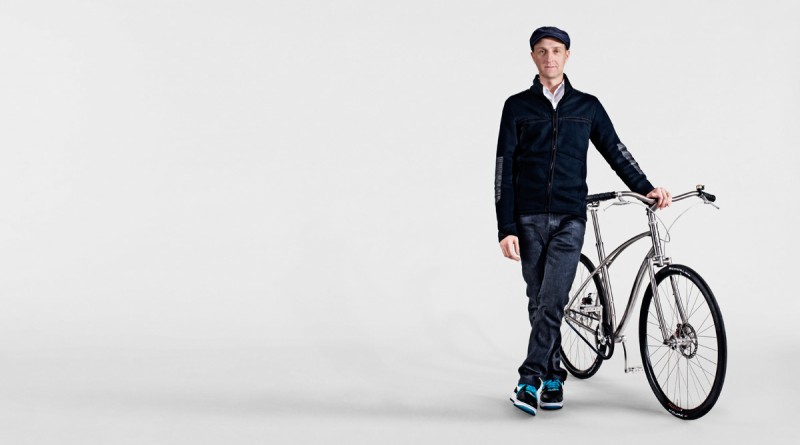Paul Budnitz designs the ultimate town bike
Why spend $5,000 on the ultimate town bike? If you truly love it, why not? says Paul Budnitz.
Pop quiz, Paul Budnitz is:
- An artist who became famous for Kidrobot, a line of high quality vinyl art toys now featured in the New York Museum of Modern Art.
- The founder of Ello, the social network national media has called one of the biggest threats to Facebook.
- A Yale graduate and an award winning filmmaker and photographer.
- The Burlington, Vt., builder of an eponymous line of gorgeous titanium bikes.
- The answer is all of the above, but you would never guess it from talking with him.
It’s a Wednesday afternoon in May and blinding sunlight is streaming into the stark, clean offices on in Burlington’s Pine Street, Vt., causing Paul Budnitz to blink. He is just back from a vacation in Provence with his wife and six-year-old daughter. He is jet-lagged and has a migraine. But the slender 47-year-old’s face lights up when he talks about the “things” he loves.
“Things – I love things, not just anything but things that really matter. I want to design things that are beautiful, and simple and make people feel good,” he says, tucking his hands in the pockets of his black hoody sweatshirt as he walks through what may be, the cleanest ‘bike shop’ in America.
About a dozen employees, all with black shirts, sit quietly staring at white Apple monitors, some working on bikes, some working on Ello, Budnitz’s other project, the emerging no-ads social network that was named one of the nine top venture capital deals of 2014 by Inc. Magazine.
A wall carries tools so meticulously hung they look like artwork. While the bikes are built in a 40-person factory in Taiwan, they are conceived and prototyped here. An array of finished titanium bikes stand gleaming by the windows, with price tags that start at $2,950 (if you opt for steel) and can go to $10,000 or more once you customize them.
They range from Model No. 1, a simple city bike with a 3.5-lb twin-tubed single-arc cantilever (the fastest and lightest ) frame, to Model No. 5, a gorgeous cruiser which inverts that trademark frame, making a classic-looking ‘women’s’ option, and adds 29-inch wheels for better all-terrain action. In between, there is the compact 24-inch-wheeled No. 4 which is described on the Budnitz website as the “grown up bad-boy bicycle,” designed to handle like a BMX bike but fit in the back of a car or a small apartment. There are also the Budnitz mountain bike and a fat tire model for riding in snow or all terrain conditions.
What’s noticeably missing from this line-up? The bike that’s usually built of titanium, the racing bike. There’s not a drop handlebar in sight. “There are plenty of racing bikes out there,” says Budnitz. “But how many people race bikes? I wanted to make bikes people would use every day, bike people will love and hold onto for years. I wanted to make bikes that make people happy when they ride them.”
Unlike most bike designers, Budnitz did not start out as what he calls “a bike geek.” He rode a bike because “driving cars got to be not fun,” —so not fun that he went for 18 years without owning a car. So not fun that “I actually moved to New York so that I didn’t have to drive,” he says.
There, he started to look for the perfect city bike.
“I would go into bike shops and ask to ride literally every bike they had in the shop,” Budnitz recalls. “I didn’t like any of them.” Then he began going back to the shop with questions and a tape measure. “I would ask stupid questions, like ‘so what’s this part?’ and the shop guy would say ‘oh, that’s a crank.’ Then I’d ask, so what makes a good one and who makes the best? Eventually, they would kick me out of the shop.”
Budnitz wanted a bike that was fun to ride, easy to store, light enough to carry up to a second-floor apartment and subtle enough not to get stolen. So Budnitz designed a bike made of titanium to be strong, light and rust-proof with no flashy logos, and one that didn’t need to be painted. A swoopy cantilevered frame not only gave it an elegant and slightly retro profile, but also helped absorb shock while still providing lateral stiffness. Grease-less Gates carbon belt drive and internal hub kept the gearing clean (and the rider’s pants).
Soon he was back at the shops. “At first, the shops were pissed,” Budnitz recalls, just a bit gleefully, “but then they rode the bike and then they wanted one.”
The components, from handlebars to headset, wheels to pedals to stem, can be built to spec with Budnitz parts (usually titanium), as well as Avid BB7 disc brakes. The bikes come with Shimano Alfine or Rohloff internal hub transmission and range from a single speed to 14-speeds (for an exra $1,700).
With this bike, as with all of his bikes, Budntiz provides a smorgasborg of options, including wood fenders handcrafted by a furniture maker in Oregon and a brass Bellini Incredibell. Next on the horizon, Budnitz bags, Budnitz watches and other accessories.
All the bikes have a certain Jackie O. pedigree to them: timeless yet cool, simple and elegant, understated, smart and fun.
“You should feel really good about what you ride and just love it,” says Budnitz. And many do: Andy Rubin, who developed the Android operating system just ordered 10 bikes for his new company. Jake Burton Carpenter of Burton bought one of the first fatbikes (painted Soviet army-tank green and red). But, as Budnitz is quick to point out, “We have bike messengers who have ordered them and paid by the month. These bikes are built to last a lifetime.” Each comes with free worldwide shipping and a 30-day guarantee.
Budnitz makes only about 250 a year. In five years, only one has been returned.
A blend of high technology and urban utilitarianism, the bikes might be what you would expect from a guy who grew up in Berkeley, Ca., the progeny of a nuclear physicist and a social worker. In high school, Budnitz spent more time writing software than riding bikes. At 15 he was being paid to write safety analysis software for nuclear power plants and create video games for the Commodore 64 home computer. When he got to Yale, though, he was done with computers, and turned his attention to studying photography, art and film. But not entirely done with them: Budnitz used his Macintosh to edit his film 93 Million Miles from the Sun. According to Wired, it was the first film ever edited on a home computer and it went on to win a prize at the 1996 Berlin International Film Festival.
Budnitz paused his filmmaking to start a company MiniDisco, hacking Sony Disc players into recording devices and built it into a $10 million business. He then sold it in 2001 to devote his attention to his newest passion: art toys.
Budnitz had seen how in Asia stylized vinyl toys were being bought, sold and collected by adults with serious a passion for them and money to spend. He began working with artists to develop limited edition collections, sold them for $5 to $5,000 (some sold for as much $25,000) and called the company he founded in 2002 Kidrobot. His books “I am plastic” and “I am plastic, too” (both published by Harry Abrams) showcase the art toy explosion and the designers behind it. In 2007, two of Budnitz’ more popular toys, Dunny and Munny, were acquired by the New York Museum of Modern Art (MOMA) for its permanent collection. The company grew to have stores in five cities, lines of apparel, events and nearly 90 employees. But, as Budnitz is the first to say, “I’m not the guy who runs a company. I’m not good with administration.”
He’s also a guy who likes a clean slate. At the height of Kidrobot’s rise Budnitz was living in an apartment in New York. One day, he took photos of everything he cared about, “things my grandmother had given, me albums, other photos, personal things” then took everything except one table, put the contents of the department on the street, and moved to Boulder, Co.
It was an effective way to downsize both his life and the company. Gradually, Budnitz transitioned himself out of Kidrobot and then sold it. Why? Well there was his new titanium bike company that was taking up more and more of his attention. In Boulder, he began to focus more and more on that. Then, two years ago, after realizing he could live anywhere, he picked up and moved to Burlington, Vt.
Budnitz’s grandmother had grown up in Bennington, he knew Vermont and it felt right. “Everywhere else feels ruined,” he says, “America has become so economically segregated. Here, I live next to a prefab home and my neighbors may not be in the same economic strata I am but we get along great.”
From his 1,500-square-foot home in Shelburne, he rides his bike up Spear Street to his offices each day. “I love the fact that there are no billboards here – that tells you who is in charge.”
Last fall, Budnitz was talking a lot about Vermont’s no-billboard law as his latest company was taking off like a meteor. Budnitz, ever the hacker, had worked with some friends and the Colorado design team Berger & Föhr to create an ad-free social network they called Ello. The network was by invitation only, would never feature ads and would never sell data. It also didn’t require you to use your real name. Over the summer of 2014, Budnitz sent out invites to a hundred or so friends, many in the design world, with the signature Ello logo, a black eye-less smiley face. And then in September a convergence of things happened that had a profound impact on the start-up. Drag queens who had been berating Facebook for not allowing them to use pseudonyms discovered Ello and started promoting it as the anti-Facebook. At the same time, Facebook’s data mining practices came under media scrutiny. By mid-September, Ello was getting as many as 40,000 sign ups in an hour.
Budnitz sought the help of friend and neighbor Cairn Cross, whose venture firm Fresh Tracks capital has funded a number of Vermont start-ups. Fresh Tracks invested $435,000. A PR firm was hired and soon Budnitz’s life went nuts: “It was liking trying to put wheels on a car as it was driving down the highway,” He says. Ello made the Wall Street Journal, the Economist, BBC, Fast Company and on and on.
Working with Fresh Tracks, Budnitz set up Ello as a public benefit corporation so that it would be legally bound in its principles to not sell data or take advertising. For other companies, that might have been a poison pill. Not so for Ello. New investment (to the tune of $5.5 million) came from a venture firm in Colorado. Soon, more than half of Ello’s team was based there. “They wanted me to move back out there as well,” says Budnitz, “but I’m staying here in Vermont.”
There is something about Vermont that seems perfect for him, “an innocence and an earnestness here and a focus on quality,” as he describes it.
Those are qualities that seem to match the man who made his fortune off art toys and the inner boy who rides his titanium bike to work.



Pingback: Vermont Sports Magazine | Your Guide to the Outdoors in Northern New England